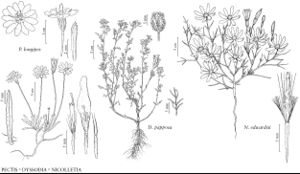Dyssodia
Descr. Pl., 202. 1802.
| Taxon | Illustrator ⠉ | |
|---|---|---|
 | Pectis longipes Dyssodia papposa Nicolletia edwardsii | John Myers Marjorie C. Leggitt Yevonn Wilson-Ramsey |
Annuals [perennials], 10–30 (–70+) cm. Stems erect to decumbent, branched from bases or throughout. Leaves cauline; mostly opposite (distal sometimes alternate); blades (1–) 2–3-pinnatisect, primary lobes linear to linear-cuneate, ultimate margins entire or toothed, faces puberulent (little, if at all, setaceous at bases, on teeth, or at tips of lobes, oil-glands submarginal). Heads radiate, borne singly or in 2s or 3s [pseudocephalia]. Calyculi of [0] 1–9 ± linear bractlets (lengths 1/2–1 phyllaries, bearing oil-glands). Involucres turbinate to campanulate [hemispheric], 5–10 mm diam. Phyllaries persistent, 6–12 in ± 2 series (distinct to bases or nearly so, oval-oblanceolate, each bearing 1–7 round to elliptic oil-glands). Receptacles convex, ± pitted (socket margins fimbrillate to setose), epaleate. Ray-florets usually 5–8, pistillate, fertile; corollas yellow-orange. Disc-florets 12–50 [–100+], bisexual, fertile; corollas yellow to orange, tubes shorter than cylindric throats, lobes 5, deltate to lance-deltate. Cypselae obpyramidal to obconic, subsericeous or glabrescent; pappi persistent, of 15–20 scales in ± 2 series (each scale comprising 5–10 basally connate, unequal bristles). x = 13.
Distribution
North America, Mexico, Central America, in South America
Discussion
Species 4 (1 in the flora).
Selected References
None.